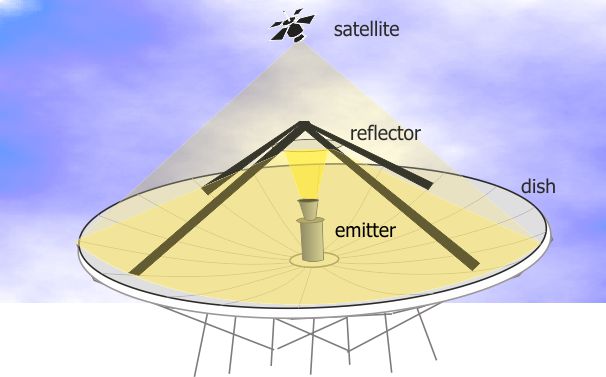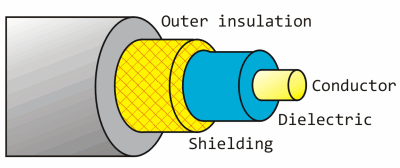Freesat reception - all about dishes
 Brian Butterworth published on UK Free TV
Brian Butterworth published on UK Free TV Satellite reception has both advantages and disadvantages compare with terrestrial (aerial) reception.
By using much higher frequencies (gigahertz, compared to terrestrial televisions megahertz) more transmission channels called transponders (the satellite equivalent of multiplexes) can be provided. For example, there are only six Freeview multiplexes, but Sky or Freesat users can access two hundred satellite transponders.
Aside from exceptional weather conditions (very heavy rain for example) digital satellite provides stable pictures and audio. Where Freeview transmitters are no more than 732 metres above sea level, the geostationary satellites used for television are 35,800,000 metres above the equator so reception is possible even where buildings, trees and hills make terrestrial reception impossible.

The downside of the transmitters being 22,300 miles up in the air is that the signals are very, very weak - so standard TV aerial is of little use. When the signals are sent to the satellites, huge dish transmitters are used to uplink the signal to the satellite. These are tens of metres from side to side, and feature an emitter that generates the signal, which is first bounced of a mirror (called a reflector) and then off the surface of the parabolic dish.

There are many satellites in the sky over the equator. Often these are in clusters over a particular position, for example there are four used for UK television are at 28.2 degrees east. There is another cluster over the 19.2 degrees east positions that are used for German television.
To receive these very weak signals from the satellite, it is necessary to use a dish for reception too. By using a reflective dish, this concentrates the signals onto a small device called a LNB. This is held in front of the dish by a metal arm.

The size of dish for reception is typically much smaller; often 60cm to 100cm in diameter, but the exact size depends upon the transmitting satellite transponder. To keep the transmission power levels down to levels that can be powered by the satellite's solar panels, each beam is focused on a particular area of the Earth's surface. If you are trying to receive the signal at the centre of this zone, a small dish is required. At the outer edges, you may need a 5 metre dish. Maps of these zones are provided by the satellite companies, and are called satellite footprints.
When the dish is installed it must be aligned carefully as the signal is very weak. The installer needs to know the inclination and the azimuth from the ground location to the satellite. If you install yourself you will find that there are markings on the dish that are used to point the dish in the correct position. It is important that the view of the satellite will not be blocked, so must take into account leaves growing on trees and potential building works.
For many people the LNB will have a single cable connected to it, however if you have Sky+ or a multi-room installation the LNB package will actually contain four receivers a quad-LNB. Unlike terrestrial television where you can split the aerial cable to feed more than one Freeview box or television set, with satelite reception you cannot. So, a Sky+ box with two receivers (so you can watch one thing and record another) has two cables connecting the box to the dish.
The cable that connects the dish to the receiver must be satellite grade cable. Whilst this looks superficially like the cable used to connect and aerial to a television, a higher grade cable is required for satellite reception.
Here is an image of a co-axial cable. This sort of cable is used to connect any type of receiving aerial to the reception equipment.

RG6, PF100 and PH100 are all types of coax cable that are suitable for the very weak signals that are received by a satellite dish. (The power is the same as you would receive from a one-bar electric heater on the moon).
The conductor in the centre passes the signals received from the dish to the set-top box. This is made from steel in RG6 cable, and from copper in the RF100 and PH100 types. This makes RG6 less suitable in the UK where rain can damage the cable.
The shielding is responsible for keeping unwanted external interference from damaging the signal. In the cheaper cable this will be a foil wrap, in better specified cables this is a braid (or mesh) of copper wires. The sheild in the RF100 covers 58% of the cable.
The non-conducting layer between the shield and the conductor is called the dielectric. This can be either a solid (RG6), foam (RF100) or air-spaced (PH100) dielectric. This makes the cables progressively more flexible (ie bendy without damage).
8:37 PM
Trevor,
I'm having a similar problem since being away for two weeks over Christmas. I have completely realigned my dish and was getting 89% quality and 92% signal readings, but the signal still fails regularly. Sometimes I can be watching a channel for many minutes with a good picture, but when I change channels there is "no signal"! Some channels have no reception at all, some I can get (almost) straight away every time. It's been stupidly damp here and although I have a silicone cover, I wonder if the moisture has still got in.
| link to this comment |
9:12 PM
Jonathan: Well with regards to the latter possibility mentioned that could well be the case, because variations in signal levels can only really be caused by either corrosion on the "F" connector plugs threads or water having gained access to its internals, and so I would carefully unscrew the connector from the LNB then further unscrew it from the coax and wipe the inside of the connector with a tissue, likewise the end of the coax making sure that all strands are pulled back over the coax outer cover, then smear some Vaseline (although silicone grease is better) on the inner barrel and re-assemble same.
I should say that LNB's can also be responsible for exactly the same symptoms, but water problems are by far the more frequent cause.
Although it appears as though you are referring to a standard Sky box, if its a Sky + type then try swapping the "F" connector inputs over, as the problem will likely move to the recording input.
| link to this comment |
9:16 PM
Jonathan: Further to that said, obviously the possible reasons mentioned would also apply if you were referring to a Freesat signal rather than Sky, as both are technically identical in this respect.
| link to this comment |
9:33 PM
My freeset has no connection. My satelitte dish is covered with snow all over the front dish. Is that affecting my freesat as its not working.
| link to this comment |
9:39 PM
Please help i need to know whether is affects my dish. Snow is covered all over the front of the dish. Its says cannot recieve this programme please check connection. So is the snow affecting it?
| link to this comment |
11:49 PM
Jeanette Betts: Yes!! Microwave band signals such as used by Freesat or Sky can get completely blocked by even the slightest amount of snow sitting on the surface of the dishes LNB as the signals from the dish bowl are focussed on this spot, the proof of this being, that should the dish be within reach then once that the signals are OK again try draping a wet dish cloth across the aforementioned LNB surface and check the results, as no doubt you will find that the signal has vanished.
| link to this comment |
11:26 AM
I have just resited myfreesat dish with quad outlets, i have used a meter to get good signal, signal and quality strength on TV both show 90% but on numerous attempts to set up tv it keeps showing "Invalid post code" or "unable to find satelite signal"
Any ideas please ?
| link to this comment |
4:59 PM
Peterborough
Spike: As far as the post code is concerned some later issue post codes are not recognised by some PVR's, if of course this situation should apply in your particular case, but try entering PE6 7XZ as this is a test code I use to enable Anglia news (West) to be the default region in areas where a persons post code results in them receiving East Midlands news.
On the subject of "unable to find a satellite signal" try swapping the two LNB inputs over on the rear of your PVR and see if this alters the message, giving an update on the result.
| link to this comment |
jb38's: mapJ's Freeview map terrainJ's terrain plot wavesJ's frequency data J's Freeview Detailed Coverage
3:03 PM
guys how do i get max signal from a split sat cable when i only have a single port for freesat on my tele
| link to this comment |
3:57 PM
rick: Only Freesat recorders require twin inputs as these devices have two tuners, Freesat TV's only require one input because recording isn't involved.
By the way Satellite cables cannot be split as control voltages are sent along the cable from the box to the dish for both band and polarity switching purposes.
| link to this comment |